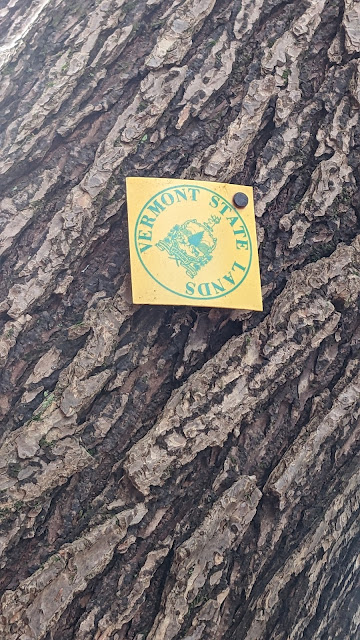Here's the thing, I really don't enjoy doing puzzles. Even so, every year for the last several years, Wayne has gifted one to me. The puzzles are quite beautiful, they are a thousand or more pieces and are nature themed. It's not what you think, I ask for the puzzles. The true gift of the puzzle is that I get to watch Wayne build them. This year the puzzle is vintage wildflowers, a theme chosen for me to be built by a content and focused Wayne, it's a perfect match.
In
part one we successfully hiked a small parcel belonging to the Roaring Brook Wildlife Management Area in north Vernon. We explored along the ridge looking for clues as to why the RBWMA chose to conserve this particular piece of land.
We came upon rocks that looked as though they had been placed on the ridge and continued just beyond it.
Wayne reminded me, that while exploring the bottom of this ridge last year, we encountered two erect stones placed in such a way that they formed a gate of sorts. We attempted to relocate the gate from on top of the ridge without success. To read about that hike and the gate in the pictures below,
click here.
Sometimes the pieces of a puzzle fit together nicely, but most of the time I rotate and pound on them insisting they go together. Arranged rocks in the woods suggests boundaries created by clearing pasture. Similarly, a gate creates a passage through a fence. This gate however, is at the bottom of the ridge while the fence seems to be on top.
While I mulled over the pieces, Wayne led us to the southern boundary before heading to the northeastern corner which looked to be more promising for pasture, but lacked the expected clues.
The Boese property in the northeast corner is posted
The stones on the way to the Brattleboro Retreat land appeared to be as perplexed as I was.
I think that this house is in Guilford.
This growth is hard, raised and rough.
Branch stripped of its bark.
Something has been eating here too.
Some pieces just fall into place.
Rising and falling levels formed these ridges of ice in the water.
Just prior to entering the Retreat property on Cersosimo land was water that was frozen over. Because other water in the area was not completely frozen over I speculated that the frozen area covered deeper water. Being so warm, we decided to not test out that theory.
Wayne noticed them first, large piles of the same sort of rock that lined the top of the ridge.
We hiked a short distance more.
I thought that we should wave to the camera; but Wayne disagreed.
From here we entered the Retreat land.
Don't get me wrong here, this is beautiful, flat, forested land.
It's just that I was hoping that the answer as to why the Brattleboro Retreat owned this property would be obvious.
We found a road where recent rains had washed out a path.
The path soon turned into running water.
The road led us out of the area without having to descend two of the steep slopes that we had climbed up earlier in the day.
Across the river in Hinsdale, Mount Wantastiquet can be seen from here. Wantastiquet was once mined for precious metal.
We could see now, that the road continued behind a business and on to Ox Cart road. Our car however was at the bottom of the hill at the setback. Down we went no wiser as to why the Retreat owns land in north Vernon. It was time to do some research.
I proceeded to search both historical and present information about the Retreat on the internet without finding any mention at all of their owning land in Vernon. I decided to email the Retreat and was told the following:
The Retreat was provided the land by Mr. Wells Goodhue on November 29, 1864. Based on what I have learned today, there was no specific purpose as mentioned in your question. The land was gifted by Mr. Goodhue. Thanks for reaching out.
Having a name to associate with my search allowed me to find the following as viewed on Google Books from
The Vermont Asylum for the Insane: Its Annals for Fifty years, Volumes 15-19:
At the close of this year forty-six acres of woodland were purchased in Vernon, of Mr. Wells Goodhue for the sum of $1,800.
I requested help from a friend who did further investigating Goodhue in
the Annals and found:
In 1847 the purchase of 30 acres along the Newfane Road, about a mile from the campus, for $1000, stating that it "was purchased principally for the fuel growing thereon, of which the Asylum had had great need." Then it says, they put the patients to work cutting firewood! Then, in 1849, they purchased 25 acres over in Chesterfield, for $250, "valuable only for fuel" And in 1855, certain lands on the mountainside for the purposes of fuel" for
$450. (Probably the mountainside west of the Retreat.) More woodland "upon the mountain" in 1858 for $840.
With a plausible answer to the Retreat land ownership question, that leaves the RBWMA question to be uncovered. So far I have studied the maps on the town website and noted that on the
existing land use by parcel map it shows the RBWMA land as: Parcel enrolled in Use Value Appraisal program, 2016.
Does this bring us closer to solving the puzzle? Truthfully I just don't know.
Oh, and I now have another question, when was that quarry on the Cersosimo land in operation and for what was the stone to be used? - Norma Manning



.jpg)
.jpg)

























.jpg)








.jpg)

















































.jpg)





